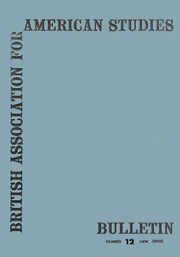49.The gloomy impression many critics seem to have taken away from this essay is, perhaps, partly owing to his proposition that, because of the self-imposed boundaries of his hedonism, Stevens had written himself out (Winters, op. cit., pp. 433, 444, 446). This might even have been justified from internal evidence for some years after the publication of Winters's essay, since
Ideas of Order,
The Man with the Blue Guitar and
Parts of a World contain much verse that seems to be self-imitation and nothing which has as much to offer as the
Harmonium poems already mentioned. But, like many long-lived poets, Stevens shows surprising powers of self-renewal.
Transport to Summer, which came out well after Blackmur and Winters had written their essays, contains
Esthetique du Mal,
Less and less human,
O savage spirit,
The House was Quiet and the World was Calm and
Notes Towards a Supreme Fiction, and was accounted by Marius Bewley (op.cit., p. 189) and A. Alvarez (op. c i t., p. 125) his best book. This was followed by
The Auroras of Autumn over whose author's powers the obsequies were pronounced – particularly by Randall Jarrell (op.cit., p. 132). Even this proved to be premature.
The Rock, which is the final section of the definitive
Collected Poems, contains work which is beginning to find acceptance among the established favourites, and three poems,
The Plain Sense of Things,
The World as Meditation and
Note on Moonlight which, in two different appreciations of Stevens's later work, Ralph J. Mills (
Gemini, Spring 1960) and D.T. Millar (
Delta, Spring 1956) ranked with the best work of his early and middle periods. However, there has not been time for criticism of his later work to accrue sufficient to justify the procedure which has been adopted with
Harmonium.
Google Scholar 



